新药I期临床试验申请技术指南
新药Ⅰ期临床试验申报资料的内容及格式要求
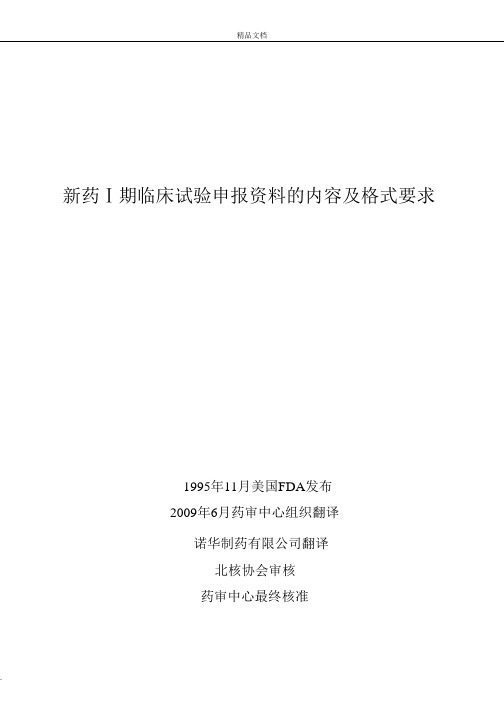
新药Ⅰ期临床试验申报资料的内容及格式要求1995年11月美国FDA发布2009年6月药审中心组织翻译诺华制药有限公司翻译北核协会审核药审中心最终核准目录I. II. III. 引言 (1)现行要求与操作规范 (2)现行新药临床申请法规的解释 (2)A. 封面(FDA格式-1571)[21 CFR 312.23(a)(1)]: (2)B. 目录[21 CFR 312.23(a)(2)]: (2)C. 介绍性声明与整体研究方案[21 CFR 312.23(a)(3)]: (2)D. 研究者手册[21 CFR 312.23(a)(5)]: (2)E. 方案[21 CFR 312.23(a)(6)]: (2)F. 化学、生产和控制信息[21 CFR 312.23(a)(7)]: (3)G. 药理学和毒理学信息[21 CFR 312.23(a)(8)]: (6)H. 研究药物既往在人体中使用的经验[21 CFR 312.23(a)(9)]: (9)I. 21 CFR 312.23(a)(10)、(11)(b)、(c)、(d)(e): (10)新药Ⅰ期临床试验申报资料的内容及格式要求I. 引言随着近期FDA成功实现《1992年处方药付费法》(PDUFA)审评行动的目标,使得从递交上市注册申请至批准上市的平均时间和中位时间均显著缩短。
FDA已将注意力转移至如何提高药品开发过程中其它部分的效率,同时保证这种效率的提高不得以牺牲美国人所期望获得的、具备长期安全性和有效性药品的标准为代价。
其中有一个IND法规特别值得关注,即关于在人体中开始进行药物试验的法规(即Ⅰ期试验),自McMahon 行动会议以来,对此课题已经进行了两年多的积极讨论,并且吸纳了各方不同层次的意见。
本指导原则阐述了在美国将研究药品(包括已进行结构确证的治疗性生物工程类产品)开始用于人体研究时,所需要提供的数据和在21 CFR 312.22和312.23中需要报告的数据1。
《化学药品创新药I期临床试验申请药学共性问题相关技术要求》
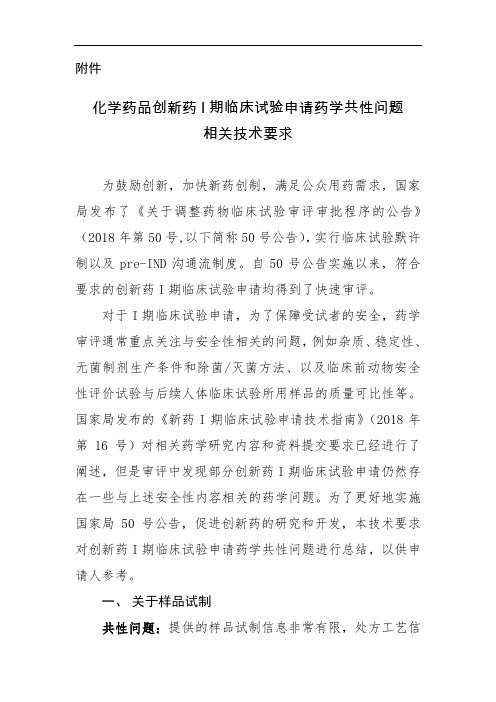
附件化学药品创新药I期临床试验申请药学共性问题相关技术要求为鼓励创新,加快新药创制,满足公众用药需求,国家局发布了《关于调整药物临床试验审评审批程序的公告》(2018年第50号,以下简称50号公告),实行临床试验默许制以及pre-IND沟通流制度。
自50号公告实施以来,符合要求的创新药I期临床试验申请均得到了快速审评。
对于I期临床试验申请,为了保障受试者的安全,药学审评通常重点关注与安全性相关的问题,例如杂质、稳定性、无菌制剂生产条件和除菌/灭菌方法、以及临床前动物安全性评价试验与后续人体临床试验所用样品的质量可比性等。
国家局发布的《新药I期临床试验申请技术指南》(2018年第16号)对相关药学研究内容和资料提交要求已经进行了阐述,但是审评中发现部分创新药I期临床试验申请仍然存在一些与上述安全性内容相关的药学问题。
为了更好地实施国家局50号公告,促进创新药的研究和开发,本技术要求对创新药I期临床试验申请药学共性问题进行总结,以供申请人参考。
一、关于样品试制共性问题:提供的样品试制信息非常有限,处方工艺信息(特别是涉及复杂原料药或者复杂制剂时)过于简单。
一般性要求:参照《新药I期临床试验申请技术指南》相关要求提供原料药和制剂的生产商、生产地址和处方工艺信息,汇总关键研究批次(包括用于安全性研究、稳定性研究、临床研究(如已制备)等批次)的试制信息、关键项目的批分析数据等。
对于复杂原料药(例如多肽、小分子核酸、聚合物产品、含多个手性中心、含发酵工艺或者天然来源等药物)、复杂制剂(例如微球/微乳/脂质体、胶束、透皮制剂、吸入制剂等)、复杂给药途径(例如制备成混悬液、乳液或者凝胶通过皮科、眼科和耳用等局部给药)以及复杂药械组合产品,应注意对重要的生产步骤、设备和工艺参数等进行较为详细的描述。
对于无菌制剂,应对无菌生产条件和除菌/灭菌方法等进行较为详细的描述,并且提供无菌保障措施。
鉴于国内目前临床试验申请为60天默许制,I期临床试验申请如果研究资料符合要求通常可快速开展临床试验,建议申报I期临床试验时(特别是涉及复杂原料药和制剂、复杂给药途径、药械组合产品时)在拟定的临床样品制备地点至少完成1批样品的制备,并且提供相关的试制信息、检验报告。
新药 期临床试验申请技术指南

附件新药I期临床试验申请技术指南一、前言为帮助新药注册申请人(药品企业、科研机构和科研人员)申请I期临床试验,提高新药研发与审评效率,保护受试者安全与权益,保证临床试验质量,特发布本技术指南。
本指南阐述了新药在我国开展首次临床试验时需要向国家食品药品监督管理总局药品审评中心(以下简称药审中心)提供的信息。
本指南的目的是:明确新药I期临床试验的技术要求,提高I 期临床试验申报资料的质量;通过规范I期临床试验资料的数据要求,缩短新药研发周期,加快新药上市进程。
本指南适用于创新药和改良型新药,包括化学药品和治疗用生物制品(细胞和基因治疗产品除外)。
二、咨询与沟通交流如果申请人在研发及申请临床试验过程中有疑问,可通过药审中心网站查询相关指导原则,也可以按照相关规范通过药审中心网站“申请人之窗”就相关问题进行咨询。
递交新药临床试验申请前,申请人可按照《药物研发与技术审评沟通交流管理办法》所规定的方法与工作程序,申请与药审中心召开临床试验申请前会议。
申请人与药审中心间的沟通有助于提高临床试验申请的质量,加快后续研究与审评的进程。
三、I期临床试验申请的技术要求(一)资料格式及内容I期临床试验申请的申报资料应以纸质资料和电子资料方式提交,电子资料可以CD的形式送交。
格式和内容可参照研究人用药品注册技术要求国际协调会(ICH)通用技术文件(CTD)的要求整理提交。
(二)介绍性说明和总体研究计划介绍性说明应包括新药的名称、所有的活性成分、药理作用类别、结构式(如果已知)、剂型、制剂处方、给药途径、临床试验目的等。
如果有所研究药物用于临床的经验,应提供简短概述,包括在其他国家的研究和上市的经验;若没有,标题下写“无”。
总体研究计划应总结申请临床试验方案的设计依据,主要为拟定的适应症、受试者人群、受试者数量、给药方案(剂量、给药间隔、给药持续时间等)、药物安全性评价方法、风险控制计划等,根据已有信息预期的任何安全性(重要的已确定风险、重要的潜在风险、重要的缺失的资料等)的风险论证。
新药I期临床试验申请技术指南(草案)160930

新药I 期临床试验申请技术指南(草案)国家食品药品监督管理总局(CFDA)2016年9月1目录一、前言 (1)二、背景 (2)三、与药审中心沟通交流 (3)四、IND提交所需的特定信息 (4)(一)规定的表格 (4)(二)文件目录 (5)(三)介绍性说明和总体研究计划 (5)(四)研究者手册 (6)(五)方案 (8)(六)化学、生产和控制信息 (9)(七)药理毒理信息 (14)(八)研究药物既往在人体使用的经验 (16)(九)其他重要信息 (17)(十)相关信息 (17)五、提交信息 (17)六、IND过程和审评过程 (18)(一)临床试验暂停要求 (19)(二)IND修订 (21)1七、申请人的其他责任 (22)(一)遵守法规伦理要求 (22)(二)监测正在进行的研究 (22)(三)研究药物的推销或付费 (23)(四)记录和报告 (23)(五)IND安全性报告 (23)(六)IND年度报告 (24)八、撤回、终止、暂停或者重新启动IND (25)附件 (26)附件1:药品注册临床试验申报资料信息表 (26)附件2:研究者声明表 (29)附件3: 化药Ⅰ期临床研究CMC资料表 (32)2新药I期临床试验申请技术指南一、前言国家食品药品监督管理总局(CFDA)发布本技术指南旨在帮助新药研发申请人提交足够的临床试验研究申请(Investigational new drug,IND)材料,以提高新药研发与审评效率,并同时能保证药品的安全性、有效性和质量可控性。
本指导原则阐述了在中国将研究药品(包括已进行结构确证的治疗性生物工程类产品)开始用于人体研究时,所需要提供的数据。
将申报资料的要求按照新药不同的研究阶段加以分类,在满足向CFDA提供评估拟进行研究所需要数据的同时,建立对同一类别IND申报的统一标准,增加IND申报要求的透明度、标准化,减少模糊性和不一致性,将有助于缩短新药批准进入临床试验的时间。
《化学药品创新药I期临床试验申请药学共性问题相关技术要求》

附件化学药品创新药I期临床试验申请药学共性问题相关技术要求为鼓励创新,加快新药创制,满足公众用药需求,国家局发布了《关于调整药物临床试验审评审批程序的公告》(2018年第50号,以下简称50号公告),实行临床试验默许制以及pre-IND沟通流制度。
自50号公告实施以来,符合要求的创新药I期临床试验申请均得到了快速审评。
对于I期临床试验申请,为了保障受试者的安全,药学审评通常重点关注与安全性相关的问题,例如杂质、稳定性、无菌制剂生产条件和除菌/灭菌方法、以及临床前动物安全性评价试验与后续人体临床试验所用样品的质量可比性等。
国家局发布的《新药I期临床试验申请技术指南》(2018年第16号)对相关药学研究内容和资料提交要求已经进行了阐述,但是审评中发现部分创新药I期临床试验申请仍然存在一些与上述安全性内容相关的药学问题。
为了更好地实施国家局50号公告,促进创新药的研究和开发,本技术要求对创新药I期临床试验申请药学共性问题进行总结,以供申请人参考。
一、关于样品试制共性问题:提供的样品试制信息非常有限,处方工艺信息(特别是涉及复杂原料药或者复杂制剂时)过于简单。
一般性要求:参照《新药I期临床试验申请技术指南》相关要求提供原料药和制剂的生产商、生产地址和处方工艺信息,汇总关键研究批次(包括用于安全性研究、稳定性研究、临床研究(如已制备)等批次)的试制信息、关键项目的批分析数据等。
对于复杂原料药(例如多肽、小分子核酸、聚合物产品、含多个手性中心、含发酵工艺或者天然来源等药物)、复杂制剂(例如微球/微乳/脂质体、胶束、透皮制剂、吸入制剂等)、复杂给药途径(例如制备成混悬液、乳液或者凝胶通过皮科、眼科和耳用等局部给药)以及复杂药械组合产品,应注意对重要的生产步骤、设备和工艺参数等进行较为详细的描述。
对于无菌制剂,应对无菌生产条件和除菌/灭菌方法等进行较为详细的描述,并且提供无菌保障措施。
鉴于国内目前临床试验申请为60天默许制,I期临床试验申请如果研究资料符合要求通常可快速开展临床试验,建议申报I期临床试验时(特别是涉及复杂原料药和制剂、复杂给药途径、药械组合产品时)在拟定的临床样品制备地点至少完成1批样品的制备,并且提供相关的试制信息、检验报告。
化药新药1类申报流程、研究内容及要求
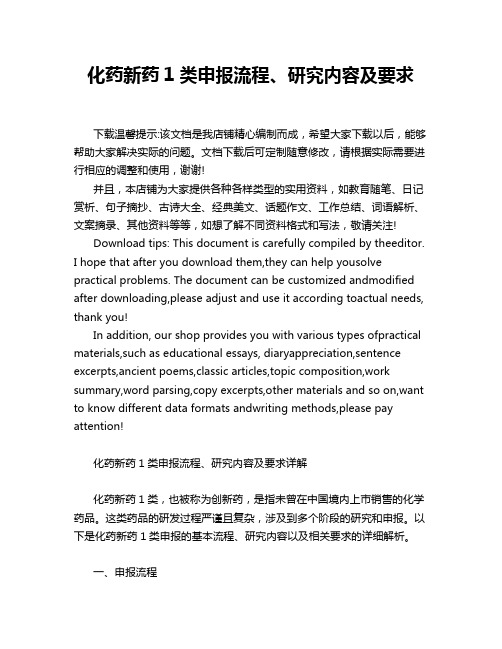
化药新药1类申报流程、研究内容及要求下载温馨提示:该文档是我店铺精心编制而成,希望大家下载以后,能够帮助大家解决实际的问题。
文档下载后可定制随意修改,请根据实际需要进行相应的调整和使用,谢谢!并且,本店铺为大家提供各种各样类型的实用资料,如教育随笔、日记赏析、句子摘抄、古诗大全、经典美文、话题作文、工作总结、词语解析、文案摘录、其他资料等等,如想了解不同资料格式和写法,敬请关注!Download tips: This document is carefully compiled by theeditor.I hope that after you download them,they can help yousolve practical problems. The document can be customized andmodified after downloading,please adjust and use it according toactual needs, thank you!In addition, our shop provides you with various types ofpractical materials,such as educational essays, diaryappreciation,sentence excerpts,ancient poems,classic articles,topic composition,work summary,word parsing,copy excerpts,other materials and so on,want to know different data formats andwriting methods,please pay attention!化药新药1类申报流程、研究内容及要求详解化药新药1类,也被称为创新药,是指未曾在中国境内上市销售的化学药品。
中药i类新药 申请

中药i类新药申请
中药i类新药的申请需要经过以下几个步骤:
1. 研究开发:中药i类新药的研究开发需要进行大量的基础研究和临床试验,以证明其治疗效果和安全性。
在研究开发过程中,需要进行药效学、药理学、毒理学、临床试验等多个方面的研究。
2. 申请临床试验批件:在完成研究开发后,需要向国家药品监督管理局(NMPA)提交临床试验申请,并获得临床试验批件。
3. 临床试验:完成临床试验后,需要将临床试验结果整理成报告,并向NMPA提交新药上市申请。
4. 新药上市申请:在提交新药上市申请时,需要提供临床试验报告、药品说明书、药品标签、质量标准、生产工艺等相关资料,并接受NMPA的审核。
5. 新药审批:NMPA对新药上市申请进行审查,包括药效学、药理学、毒理学、临床试验数据、安全性、质量控制等方面的审查。
如果符合要求,将颁发新药批准证书,允许上市销售。
需要注意的是,中药i类新药的研究开发和申请过程较为复杂,需要耗费大量的时间和资金。
同时,由于中药的特殊性质,其研究开发和审批过程也存在一定的难度和挑战。
新药I期临床试验申请技术指南

新药I期临床试验申请技术指南一、背景与目的:新药I期临床试验是新药研发的第一个阶段,目的是评估药物的药代动力学特性、药效学特性和耐受性,以确定药物的合理剂量和给药方案,并初步评估其治疗效果和安全性。
本技术指南旨在提供新药I期临床试验申请的相关技术要求和指导。
二、申请材料:1.临床试验药物信息:包括药物的命名、化学结构、物理化学性质、质量规格等;2.临床试验计划书:详细描述试验设计、纳入标准、排除标准、剂量选择、给药方案、随访计划等;3.试验药物处方信息:根据相关法规和规定提供试验药物的处方格式,包括药物名称、规格、用法、用量等;4.试验药物生产、质量控制和储存情况:提供药物的生产过程、质量控制标准和方法,以及药物的储存条件和期限;5.试验计划实施能力:提供研究者团队的相关资格证明和研究设施的评估报告;6.试验受试者招募和知情同意:提供试验受试者招募计划和知情同意书的样本;7.预期试验结果和安全性评价:提供预期试验结果和安全性的评价,包括预计的不良事件和副作用,并提供监测和报告计划。
三、技术要求:1.试验设计:明确试验的目标、纳入和排除标准、随机方法、对照组设计等,确保试验结果的可靠性和可比性;2.试验药物剂量选择和给药方案:根据预期的药效学特性和药代动力学特性,选择合适的剂量范围和给药途径,并制定详细的给药方案;3.试验受试者安全保障:确保参与试验的受试者的安全和福利,包括对不良事件的监测和评估,以及适时的疾病治疗;4.试验过程控制:确保试验过程的准确性和可追溯性,包括试验药物使用记录、试验数据的收集和管理,以及试验所需设备和设施的质量控制;5.试验结果分析和解释:对试验结果进行合理的统计分析和解释,确保结果的真实可靠性和科学性;6.试验报告和沟通:根据临床试验的相关法规和规定编写试验报告,并与相关部门和机构进行有效的沟通,诚信地提交试验结果和相关数据。
四、其他注意事项:1.临床试验应遵守当地和国际相关法规和伦理准则,确保试验的科学性、伦理性和安全性;2.临床试验应严格保护试验受试者的隐私和个人信息,确保试验过程的合法性和合规性;3.临床试验应进行充分的试验前准备工作,包括研究者的培训和试验设施的准备;4.临床试验的相关数据应进行严格的质量控制和管理,确保数据的准确性和可靠性;5.临床试验应建立有效的监管和审核机制,确保试验过程和结果的合规性和安全性;6.相关研究机构和人员应具备相关的执业资质和研究能力,确保试验的科学性和可靠性;7.临床试验结果应及时向相关部门和机构进行报告和沟通,确保试验结果的公正和透明。
中药新药临床研究的技术要求
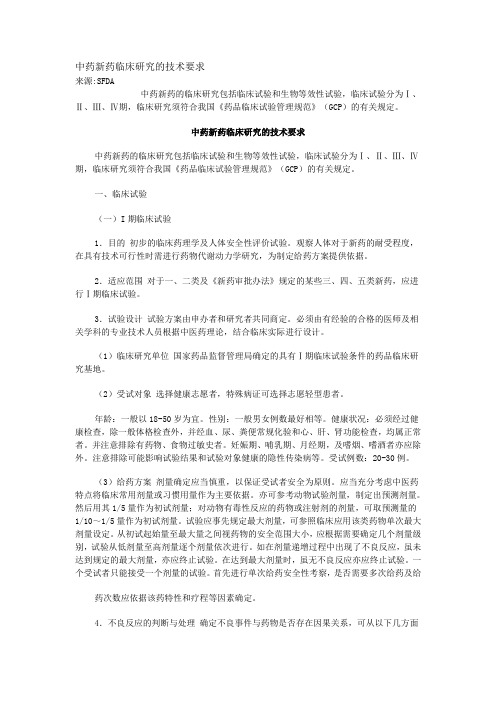
中药新药临床研究的技术要求来源:SFDA中药新药的临床研究包括临床试验和生物等效性试验,临床试验分为Ⅰ、Ⅱ、Ⅲ、Ⅳ期,临床研究须符合我国《药品临床试验管理规范》(GCP)的有关规定。
中药新药临床研究的技术要求中药新药的临床研究包括临床试验和生物等效性试验,临床试验分为Ⅰ、Ⅱ、Ⅲ、Ⅳ期,临床研究须符合我国《药品临床试验管理规范》(GCP)的有关规定。
一、临床试验(一)I期临床试验1.目的初步的临床药理学及人体安全性评价试验。
观察人体对于新药的耐受程度,在具有技术可行性时需进行药物代谢动力学研究,为制定给药方案提供依据。
2.适应范围对于一、二类及《新药审批办法》规定的某些三、四、五类新药,应进行Ⅰ期临床试验。
3.试验设计试验方案由申办者和研究者共同商定。
必须由有经验的合格的医师及相关学科的专业技术人员根据中医药理论,结合临床实际进行设计。
(1)临床研究单位国家药品监督管理局确定的具有Ⅰ期临床试验条件的药品临床研究基地。
(2)受试对象选择健康志愿者,特殊病证可选择志愿轻型患者。
年龄:一般以18-50岁为宜。
性别:一般男女例数最好相等。
健康状况:必须经过健康检查,除一般体格检查外,并经血、尿、粪便常规化验和心、肝、肾功能检查,均属正常者。
并注意排除有药物、食物过敏史者。
妊娠期、哺乳期、月经期,及嗜烟、嗜酒者亦应除外。
注意排除可能影响试验结果和试验对象健康的隐性传染病等。
受试例数:20-30例。
(3)给药方案剂量确定应当慎重,以保证受试者安全为原则。
应当充分考虑中医药特点将临床常用剂量或习惯用量作为主要依据。
亦可参考动物试验剂量,制定出预测剂量。
然后用其1/5量作为初试剂量;对动物有毒性反应的药物或注射剂的剂量,可取预测量的1/10~1/5量作为初试剂量。
试验应事先规定最大剂量,可参照临床应用该类药物单次最大剂量设定。
从初试起始量至最大量之间视药物的安全范围大小,应根据需要确定几个剂量级别,试验从低剂量至高剂量逐个剂量依次进行。
新药Ⅰ期临床试验申报 的内容及格式要求
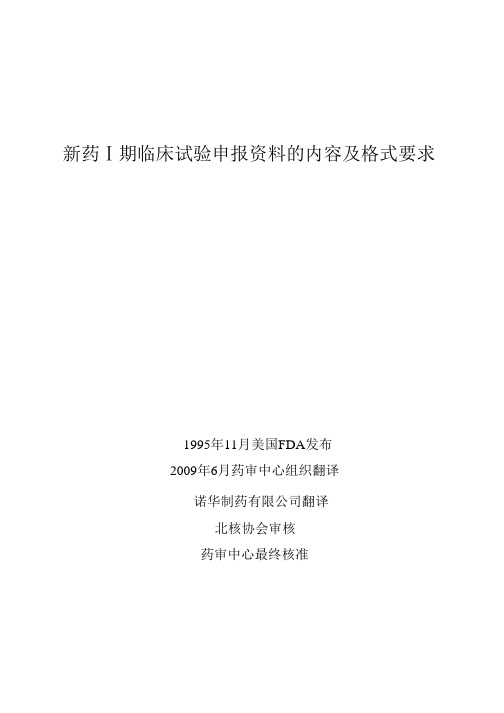
新药Ⅰ期临床试验申报资料的内容及格式要求1995年11月美国FDA发布2009年6月药审中心组织翻译诺华制药有限公司翻译北核协会审核药审中心最终核准目录I. II. III. 引言 (1)现行要求与操作规范 (2)现行新药临床申请法规的解释 (2)A. 封面(FDA格式-1571)[21 CFR (a)(1)]: (2)B. 目录[21 CFR (a)(2)]: (2)C. 介绍性声明与整体研究方案[21 CFR (a)(3)]: (2)D. 研究者手册[21 CFR (a)(5)]: (2)E. 方案[21 CFR (a)(6)]: (2)F. 化学、生产和控制信息[21 CFR (a)(7)]: (3)G. 药理学和毒理学信息[21 CFR (a)(8)]: (6)H. 研究药物既往在人体中使用的经验[21 CFR (a)(9)]: (9)I. 21 CFR (a)(10)、(11)(b)、(c)、(d)(e): (10)新药Ⅰ期临床试验申报资料的内容及格式要求I. 引言随着近期FDA成功实现《1992年处方药付费法》(PDUFA)审评行动的目标,使得从递交上市注册申请至批准上市的平均时间和中位时间均显着缩短。
FDA已将注意力转移至如何提高药品开发过程中其它部分的效率,同时保证这种效率的提高不得以牺牲美国人所期望获得的、具备长期安全性和有效性药品的标准为代价。
其中有一个IND法规特别值得关注,即关于在人体中开始进行药物试验的法规(即Ⅰ期试验),自McMahon 行动会议以来,对此课题已经进行了两年多的积极讨论,并且吸纳了各方不同层次的意见。
本指导原则阐述了在美国将研究药品(包括已进行结构确证的治疗性生物工程类产品)开始用于人体研究时,所需要提供的数据和在21 CFR 和中需要报告的数据1。
现有法规对IND申报资料中要求提交的各数据数量和程度给予了很大的灵活性,其中大部分取决于所处于的研究阶段和需要进行的特殊人体试验。
FDA-NDA新药Ⅰ期临床试验申报资料(英语原文)
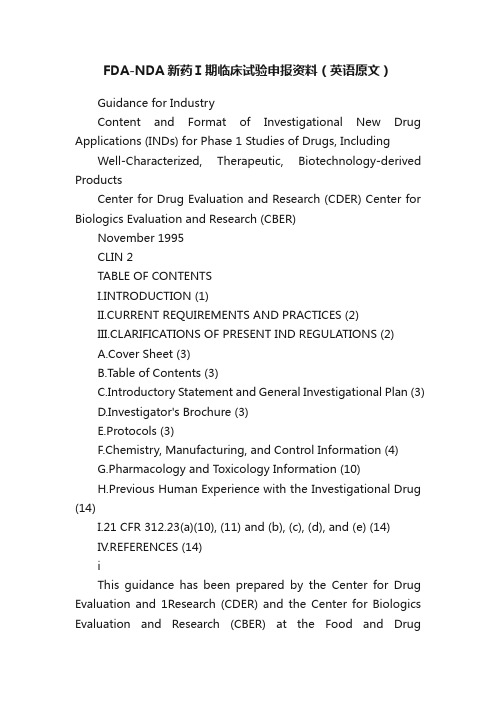
FDA-NDA新药Ⅰ期临床试验申报资料(英语原文)Guidance for IndustryContent and Format of Investigational New Drug Applications (INDs) for Phase 1 Studies of Drugs, Including Well-Characterized, Therapeutic, Biotechnology-derived ProductsCenter for Drug Evaluation and Research (CDER) Center for Biologics Evaluation and Research (CBER)November 1995CLIN 2TABLE OF CONTENTSI.INTRODUCTION (1)II.CURRENT REQUIREMENTS AND PRACTICES (2)III.CLARIFICATIONS OF PRESENT IND REGULATIONS (2)A.Cover Sheet (3)B.Table of Contents (3)C.Introductory Statement and General Investigational Plan (3)D.Investigator's Brochure (3)E.Protocols (3)F.Chemistry, Manufacturing, and Control Information (4)G.Pharmacology and Toxicology Information (10)H.Previous Human Experience with the Investigational Drug(14)I.21 CFR 312.23(a)(10), (11) and (b), (c), (d), and (e) (14)IV.REFERENCES (14)iThis guidance has been prepared by the Center for Drug Evaluation and 1Research (CDER) and the Center for Biologics Evaluation and Research (CBER) at the Food and DrugAdministration. Although this guidance does not create or confer any rights for or on any person and does not operate to bind FDA or the industry, it does rep resent the agency’s current thinking on data requirement issues related to the initial entry of an unapproved drug into human studies in the United States. For additional copies of this guidance, contact the Consumer Affairs Branch (formerly the Executive Secretariat Staff), HFD-210, CDER, FDA, 5600 Fishers Lane, Rockville, MD 20857 (Phone: 301-594-1012) or the Congressional and Consumer Affairs Branch (HFM-12), CBER, FDA, 1401 Rockville Pike (STE 200N), Rockville, MD 20852-1448(Phone: 301-594-1800 or 800-835-4709). An electronic version of this guidance is also available via Internet by connecting to the CDER file transfer protocol (FTP)server (/doc/137698177.html,).As used throughout this guidance, the term "drugs" includes well-characterized,2therapeutic, biotechnology-derived products.GUIDANCE FOR INDUSTRY 1CONTENT AND FORMATOF INVESTIGATIONAL NEW DRUG APPLICATIONS (INDs) FOR PHASE 1 STUDIES OF DRUGS, INCLUDING WELL- CHARACTERIZED, THERAPEUTIC, BIOTECHNOLOGY-DERIVEDPRODUCTSI.INTRODUCTIONWith FDA's recent successes in meeting the Prescription Drug User Fee Act of 1992 (PDUFA) review action performance goals, and the resulting significant declines in mean and median time from submission of a marketing application to approval for marketing, attention has turned to increasing the efficiency ofother components of the drug development process without sacrificing the long-standing safety and efficacy standards Americans expect their drug products to meet. One part of IND regulation of particular interest - under active discussion for more than two years and the subject of various degrees of attention since the McMahon Committee - is the regulation of the initial testing of drugs in humans (i.e., Phase 1 trials).This guidance clarifies requirements for data and data presentation in 21 CFR 312.22 and 312.23 related to the initial entry into human studies in the United States of an investigational drug, including well-characterized, therapeutic,biotechnology-derived products . Present regulations allow a great deal of 2flexibility in the amount and depth of various data to be submitted in an INDdepending in large part on the phase of investigation and the specific humantesting being proposed. In some cases, the extent of that flexibility has not been appreciated. FDA believes clarifications of many of these requirements will help expedite entry of new drugs into clinical testing by increasing transparency and reducing ambiguity and inconsistencies, and by reducing the amount of information submitted, while providing FDA with the data it needs to assess the safety of the proposed Phase 1 study. If the guidance specified in thisdocument is followed, IND submissions for Phase 1 studies should usually notbe larger than two to three, three inch, 3-ring binders ("jackets").The most significant clarifications are: 1) the explicit willingness to accept anintegrated summary report of toxicology findings based upon the unaudited draft toxicologic reports of completed animal studies as initial support for humanstudies, and 2) specific manufacturing data appropriate for a Phase 1investigation. For products not covered by this Guidance, other FDA guidance documents should be consulted. In addition, the Center responsible for theproduct may be contacted for guidance.Because of the manufacturing and toxicologic differences between well-characterized, therapeutic, biotechnology-derived products and other biologicproducts, this Guidance only applies to drugs and well-characterized,therapeutic, biotechnology-derived products. For products not covered by thisGuidance, the Center responsible for the product should be contacted forguidance.This guidance applies equally to both commercial and individual investigatorsponsored INDs.II.CURRENT REQUIREMENTS AND PRACTICESUnder current regulations, any use in the United States of a drug product notpreviously authorized for marketing in the United States first requiressubmission of an IND to the FDA. Current regulations at 21 CFR 312.22 and312.23 contain the general principles underlying the IND submission and thegeneral requirements for an IND's content and format.III.CLARIFICATIONS OF PRESENT IND REGULATIONSAn IND submission for Phase 1 studies is required by regulation to contain thesections enumerated below. Clarifications are described when appropriatebeneath each section heading.2A.Cover Sheet (FDA Form-1571) [21 CFR 312.23(a)(1)]:No clarifications.B.Table of Contents [21 CFR 312.23(a)(2)]:No clarifications.C.Introductory Statement and General Investigational Plan[21 CFR312.23(a)(3)]:Regulations repeatedly describe this section as brief. Ordinarily, two tothree pages should suffice. The information requested here is intendedto place the developmental plan for the drug into perspective and to help FDA anticipate sponsor needs. Often a sponsor in the first humanstudies is simply attempting to determine early pharmacokinetic andperhaps early pharmacodynamic properties of the drug. Detaileddevelopmental plans are contingent on the outcomes of such studies. In that case, sponsors should simply state this in this section and notattempt to develop and write detailed developmental plans that will, in all likelihood, change considerably should the product proceed to furtherdevelopment.D.Investigator's Brochure [21 CFR 312.23(a)(5)]:Under the auspices of the International Conference on Harmonization(ICH), a document that provides general guidance on the Investigator'sBrochure has been developed and will soon be published in the FederalRegister (Good Clinical Practice: Guideline for the Investigator'sBrochure). Sponsors are referred to this document for further information on recommended elements of an Investigator's Brochure.E.Protocols [21 CFR 312.23(a)(6)]:The regulation requires submission of a copy of the protocol for theconduct of each proposed clinical trial. Sponsors are reminded that theregulations were changed in 1987 specifically to allow Phase 1 studyprotocols to be less detailed and more flexible than protocols for Phase 2 or 3 studies. This change recognized that these protocols are part of an early learning process and should be adaptable as information isobtained, and that the principal concern at this stage of development isthat the study be conducted safely. The regulations state that Phase 1protocols should be directed primarily at providing an outline of the3investigation: an estimate of the number of subjects to be included; adescription of safety exclusions; and a description of the dosing plan,including duration, dose, or method to be used in determining dose. Inaddition, such protocols should specify in detail only those elements ofthe study that are critical to subject safety, such as: 1) necessarymonitoring of vital signs and blood chemistries and 2) toxicity-basedstopping or dose adjustment rules. In addition, the regulations state that modifications of the experimental design of Phase 1 studies that do notaffect critical safety assessments are required to be reported to FDAonly in the IND annual report.F.Chemistry, Manufacturing, and Control Information [21 CFR312.23(a)(7)]:The regulations at 312.23(a)(7)(i) emphasize the graded nature ofmanufacturing and controls information. Although in eachinvestigation sufficient information should be submitted to assure theproper identification, quality, purity, and strength of the investigationaldrug, the amount of information needed to make that assurance will vary with the phase of the investigation, the proposed duration of theinvestigation, the dosage form, and the amount of information otherwiseavailable. For example, although stability data are required in all phases of the IND to demonstrate that the new drug substance and drug product are within acceptable chemical and physical limits for the plannedduration of the proposed clinical investigation, if very short-term tests are proposed, the supporting stability data can be correspondingly verylimited.It is recognized that modifications to the method of preparation of the new drug substance and dosage form, and even changes in the dosage form itself, are likely as the investigation progresses. The emphasis in an initial Phase 1 CMC submission should, therefore, generally be placed on providing information that will allow evaluation of the safety of subjects in the proposed study. The identification of a safety concern or insufficientdata to make an evaluation of safety is the only basis for a clinical holdbased on the CMC section.Reasons for concern may include, for example: 1) a productunknown or impure components; 2) a product possessing chemicalstructures of known or highly likely toxicity; 3) a product that cannotremain chemically stable throughout the testing program proposed; or 4)a product with an impurity profile indicative of a potential health hazard oran impurity profile insufficiently defined to assess a potential health4hazard; or 5) a poorly characterized master or working cell bank.In addition, for pre-clinical studies to be useful in assuring the safety of human studies, sponsors should be able to relate the drug product being proposed for use in a clinical study to the drug product used in the animal toxicology studies that support the safety of the proposed human study. The information discussed in the following numbered paragraphs should usually suffice for a meaningful review of the manufacturing procedures for drug products used in Phase 1 clinical studies. Additional information should ordinarily be submitted for review of the larger-scale manufacturing procedures used to produce drug products for Phase 2 or Phase 3 clinical trials or as part of the manufacturing section of a marketing application. Any questions sponsors have about potential large scale IND clinical trials or potential marketing application manufacturing requirements or specifications should be directed to the appropriate division in the CDER Office of New Drug Chemistry, or the appropriate CBERdivision with responsibility for the product, for clarification and discussion. As clinical development of a drug product proceeds, sponsors should discuss the manufacturing data that will be needed to support the safe use of their products in Phase 2 and 3 trials with the appropriate division in the CDER Office of New Drug Chemistry, or the appropriate CBER division with responsibility for the product.1.Chemistry and Manufacturing Introduction:At the beginning of this section, the sponsor should state whetherit believes: 1) the chemistry of either the drug substance or thedrug product, or 2) the manufacturing of either the drug substance or the drug product, presents any signals of potential human risk.If so, these signals of potential risks should be discussed, and thesteps proposed to monitor for such risk(s) should be described, orthe reason(s) why the signal(s) should be dismissed should bediscussed.In addition, sponsors should describe any chemistry andmanufacturing differences between the drug product proposed forclinical use and the drug product used in the animal toxicologytrials that formed the basis for the sponsor's conclusion that it was safe to proceed with the proposed clinical study. How these differences might affect the safety profile of the drugshould be discussed. If there are no differences in the products,that should be stated.52.Drug Substance [312.23 (a)(7)(iv)(a)]:Sponsors are reminded that, under present regulations, references to the current edition of the USP-NF may be used to satisfy someof the requirements, when applicable.Information on the drug substance should be submitted in a summary report containing the following items.a. A description of the drug substance, including itsphysical, chemical, or biological characteristics:A brief description of the drug substance and someevidence to support its proposed chemical structure should be submitted. It is understood that the amount of structure information will be limited in the early stage of drugdevelopment.b.The name and address of its manufacturer:The full street address of the manufacturer of the clinicaltrial drug substance should be submitted.c.The general method of preparation of the drugsubstance:A brief description of the manufacturing process, including alist of the reagents, solvents, and catalysts used, should be submitted. A detailed flow diagram is suggested as theusual, most effective, presentation of this information.More information may be needed to assess the safety ofbiotechnology-derived drugs or drugs extracted fromor animal sources.d.The acceptable limits and analytical methods used toassure the identity, strength, quality, and purity ofthe drug substance:A brief description of the test methods used should besubmitted. Proposed acceptable limits supported by simple analytical data, (e.g., IR spectrum to prove the identity, and HPLC chromatograms to support the purity level andimpurities profile) of the clinical trials material should be6provided. Submission of a copy of the certificate of analysis is also suggested. The specific methods will depend on the source and type of drug substance (e.g., animal source,plant extract, radiopharmaceutic, other biotechnology-derived products). Validation data and establishedspecifications ordinarily need not be submitted at the initial stage of drug development. However, for some well-characterized, therapeutic biotechnology-derived products, preliminary specifications and additional validation data may be needed in certain circumstances to ensure safety inPhase 1./doc/137698177.html,rmation to support the stability of the drugsubstance during the toxicologic studies and theproposed clinical study(ies):A brief description of the stability study and the test methodsused to monitor the stability of the drug substance should besubmitted. Preliminary tabular data based onrepresentative material may be submitted. Neither detailed stability data nor the stability protocol should be submitted.3.Drug Product [21 CFR 312.23 (a)(7)(iv)(b)]:Sponsors are reminded that, under present regulations, references to the current edition of the USP-NF may be used to satisfy someof these requirements, when applicable.Information on the drug product should be submitted in a summary report containing the following items:a. A list of all components, which may includereasonable alternatives for inactive compounds, usedin the manufacture of the investigational drugproduct, including both those components intendedto appear in the drug product and those which maynot appear, but which are used in the manufacturingprocess:A list of usually no more than one or two pages of writteninformation should be submitted. The quality (e.g., NF,ACS) of the inactive ingredients should be cited. For novel excipients, additional manufacturing information may be7necessary.b.Where applicable, the quantitative composition of theinvestigational new drug product, including anyreasonable variations that may be expected duringthe investigational stage:A brief summary of the composition of the investigationalnew drug product should be submitted. In most cases,information on component ranges is not necessary.c.The name and address of the drug productmanufacturer:The full street address(es) of the manufacturer(s) of theclinical trial drug product should be submitted.d. A brief, general description of the method ofmanufacturing and packaging procedures asappropriate for the product:A diagrammatic presentation and a brief written descriptionof the manufacturing process should be submitted, including sterilization process for sterile products. Flow diagrams are suggested as the usual, most effective, presentations of this information.e.The acceptable limits and analytical methods used toassure the identity, strength, quality, and purity ofthe drug product:A brief description of the proposed acceptable limits and thetest methods used should be submitted. Tests that should be submitted will vary according to the dosage form. Forexample, for sterile products, sterility and non-pyrogenicity tests should be submitted. Submission of a copy of thecertificate of analysis of the clinical batch is also suggested.Validation data and established specifications need not be submitted at the initial stage of drug development. For well- characterized, therapeutic, biotechnology-derived products, adeaute assessment of bioactivity and preliminaryspecifications should be available.8/doc/137698177.html,rmation to support the stability of the drugsubstance during the toxicologic studies and theproposed clinical study(ies):A brief description of the stability study and the test methodsused to monitor the stability of the drug product packaged inthe proposed container/closure system and storageconditions should be submitted. Preliminary tabular databased on representative material may be submitted.Neither detailed stability data nor the stability protocolshould be submitted.4. A brief general description of the composition,manufacture, and control of any placebo to be used in the proposed clinical trial(s) [21 CFR 312.23(a)(7)(iv)(c)]:Diagrammatic, tabular, and brief written information should besubmitted.5. A copy of all labels and labeling to be provided to eachinvestigator [21 CFR 312.23(a)(7)(iv)(d)]:A mock-up or printed representation of the proposed labeling thatwill be provided to investigator(s) in the proposed clinical trialshould be submitted. Investigational labels must carry a "caution"statement as required by 21 CFR 312.6(a). That statement reads:"Caution: New Drug - Limited by Federal (or United States) law toinvestigational use."6. A claim for categorical exclusion from or submission of anenvironmental assessment [21 CFR 312.23(a)(7)(iv)(e)]:FDA believes the great majority of products should qualifyfor acategorical exclusion. Sponsors who believe their investigationalproduct meets the exclusion categories under 21 CFR 25.24 should submit a statement certifying that their product meets theexclusion requirements and requesting a categorical exclusion onthat basis. (For INDs submitted to CDER, see Guidance forIndustry for the Submission of Environmental Assessments forHuman Drug Applications and Supplements, November, 1995.)9G.Pharmacology and Toxicology Information [21 CFR 312.23(a)(8)]:[The following pharmacology and toxicology guidance is applicable to allphases of IND development of products covered by this guidance.]1.Pharmacology and Drug Distribution [21 CFR312.23(a)(8)(i)]:This section should contain, if known: 1) a description of the pharmacologic effects and mechanism(s) of actions of the drug inanimals, and 2) information on the absorption, distribution, metabolism, and excretions of the drug. The regulations do notfurther describe the presentation of these data, in contrast to themore detailed description of how to submit toxicologic data. Asummary report, without individual animal records or individualstudy results, usually suffices. In most circumstances, five pagesor less should suffice for this summary. If this information is notknown, it should simply be so stated.To the extent that such studies may be important to address safetyissues, or to assist in evaluation of toxicology data, they may benecessary; however, lack of this potential effectiveness informationshould not generally be a reason for a Phase 1 IND to be placedon clinical hold.2.Toxicology: Integrated Summary [21 CFR312.23(a)(8)(ii)(a)]Present regulations require an integrated summary of thetoxicologic effects of the drug in animals and in vitro. Theparticular studies needed depend on the nature of the drug and thephase of human investigation. When species specificity,immunogenicity, or other considerations appear to make many orall toxicological models irrelevant, sponsors are encouraged tocontact the agency to discuss toxicological testing.The regulations are not specific as to the nature of the report oftoxicology data needed in an IND submission and the nature of thestudy reports upon which the report submitted to the IND is based.The regulations are silent on whether the submitted material should be based on: 1) "final fully quality-assured" individual studyreports, or 2) earlier, unaudited draft toxicologic reports of thecompleted study(ies). Most sponsors have concluded that a10submission based on final fully quality-assured individual study reports is required, and a substantial delay in submission of an IND for several months is often encountered to complete such final fully quality-assured individual reports from the time the unaudited draft toxicologic reports of the completed studies are prepared.Moreover, although the regulation does not specifically require individual toxicology study reports to be submitted, referring only to an integrated summary of the toxicologic findings, the requirement at 21 CFR 312.23(a)(8)(ii)(b) for a full tabulation of data from each study suitable for detailed review has led most sponsors to provide detailed reports of each study.Although the GLP and quality assurance processes and principles are critical for the maintenance of a toxicology study system that is valid and credible, it is unusual, as far as FDA is aware, for findings in the unaudited draft toxicologic report of the completed studies to change during the production of the"final," quality-assured individual study reports in ways important to determining whether use in humans is safe.Therefore, if final, fully quality-assured individual study reports are not available at the time of IND submission, an integrated summary report of toxicologic findings based on the unaudited draft toxicologic reports of the completed animal studies may be submitted. This integrated summary report should represent the sponsor's evaluation of the animal studies that formed the basis for the sponsor's decision that the proposed human studies are safe. It is expected that the unaudited draft reports that formed the basis of this decision might undergo minor modifications during final review and quality assurance auditing. Full toxicology department individual study reports should be available to FDA, upon request, and individual study reports should be available to FDA, upon request, as final, fully quality-assured documents within 120 days of the start of the human study for which the animal study formed part of the safety conclusion basis. These final reports should contain in the introduction any changes from those reported in the integrated summary. If there are no changes, that should be so stated clearly at the beginning of the final, fully quality-assured report.If the integrated summary is based upon unaudited draft reports,11sponsors should submit an update to their integrated summary by120 days after the start of the human study(ies) identifying anydifferences found in the preparation of the final fully quality-assured study reports and the information submitted in the initialintegrated summary. If there were no differences found, that should be stated in the integrated summary update..In addition, any new finding discovered during the preparation ofthe final, fully quality-assured individual study reports that couldaffect subject safety must be reported to FDA under 21 CFR 312.32.Usually, 10 to 15 pages of text with additional tables (as needed)should suffice for the integrated summary. It should represent thesponsor's perspective on the completed animal studies at the timethe sponsor decided human trials were appropriate. Use of visualdata displays (e.g., box plots, stem and leaf displays, histogramsor distributions of lab results over time) will facilitate description ofthe findings of these trials.The summary document should be accurate contemporaneouslywith the IND submission (i.e., it should be updated so that if newinformation or findings from the completed animal studies havebecome known since the sponsor's decision that the proposedhuman study is safe, such new information should also be includedin the submitted summary).The integrated summary of the toxicologic findings of thecompleted animal studies to support the safety of the proposedhuman investigation should ordinarily contain the following information:a. A brief description of the design of the trials and anydeviations from the design in the conduct of the trials. Inaddition, the dates of the performance of the trials should be included. Reference to the study protocol and protocolamendments may suffice for some of this information.b. A systematic presentation of the findings from the animaltoxicology and toxicokinetic studies. Those findings that an informed and experienced expert would reasonablyconsider as possible signals of human risk should behighlighted. The format of this part of the summary may be12approached from a "systems review" perspective: (e.g.,CNS, cardiovascular, pulmonary, gastrointestinal, renal,hepatic, genitourinary, hematopoietic and immunologic, and dermal). If a product's effects on a particular body systemhave not been assessed, that should be so noted. If anywell-documented toxicological "signal" is not consideredevidence of human risk, the reason should be given. Inaddition, the sponsor should note whether these findingsare discussed in the investigator's brochure.c.Identification and qualifications of the individual(s) whoevaluated the animal safety data and concluded that it isreasonably safe to begin the proposed human study. Thisperson(s) should sign the summary attesting that thesummary accurately reflects the animal toxicology data from the completed studies.d. A statement of where the animal studies were conductedand where the records of the studies are available forinspection, should an inspection occur.e.As required under 21 CFR 312.23(a)(8)(iii), a declarationthat each study subject to good laboratory practices (GLP) regulations was performed in full compliance with GLPs or, if the study was not conducted in compliance with thoseregulations, a brief statement of the reason for thenoncompliance and the sponsor's view on how such non-compliance might affect the interpretations of the findings.NOTE: The information described in paragraphs "c", "d", and "e"may be supplied as part of the integrated summary or as part ofthe full data tabulations described below.3.Toxicology - Full Data Tabulation [21 CFR312.23(a)(8)(ii)(b)]:The sponsor should submit, for each animal toxicology study thatis intended to support the safety of the proposed clinicalinvestigation, a full tabulation of data suitable for detailed review.This should consist of line listings of the individual data points,。
化药新药1类申报流程、研究内容及要求

化药新药1类申报流程、研究内容及要求下载提示:该文档是本店铺精心编制而成的,希望大家下载后,能够帮助大家解决实际问题。
文档下载后可定制修改,请根据实际需要进行调整和使用,谢谢!本店铺为大家提供各种类型的实用资料,如教育随笔、日记赏析、句子摘抄、古诗大全、经典美文、话题作文、工作总结、词语解析、文案摘录、其他资料等等,想了解不同资料格式和写法,敬请关注!Download tips: This document is carefully compiled by this editor. I hope that after you download it, it can help you solve practical problems. The document can be customized and modified after downloading, please adjust and use it according to actual needs, thank you! In addition, this shop provides you with various types of practical materials, such as educational essays, diary appreciation, sentence excerpts, ancient poems, classic articles, topic composition, work summary, word parsing, copy excerpts, other materials and so on, want to know different data formats and writing methods, please pay attention!一、申报流程1. 准备阶段。
审查申报资格:确保符合申报条件。
最新新药I期临床试验设计的要点
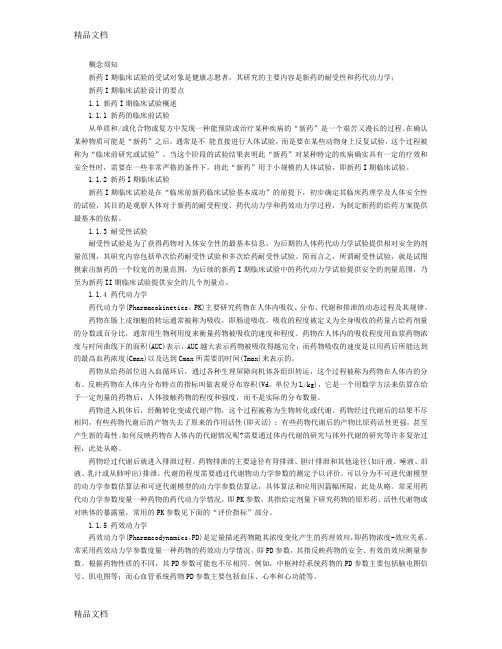
概念须知新药I期临床试验的受试对象是健康志愿者,其研究的主要内容是新药的耐受性和药代动力学;新药I期临床试验设计的要点1.1 新药I期临床试验概述1.1.1 新药的临床前试验从单质和/或化合物或复方中发现一种能预防或治疗某种疾病的“新药”是一个艰苦又漫长的过程。
在确认某种物质可能是“新药”之后,通常是不能直接进行人体试验,而是要在某些动物身上反复试验,这个过程被称为“临床前研究或试验”。
当这个阶段的试验结果表明此“新药”对某种特定的疾病确实具有一定的疗效和安全性时,需要在一些非常严格的条件下,将此“新药”用于小规模的人体试验,即新药I期临床试验。
1.1.2 新药I期临床试验新药I期临床试验是在“临床前新药临床试验基本成功”的前提下,初步确定其临床药理学及人体安全性的试验,其目的是观察人体对于新药的耐受程度、药代动力学和药效动力学过程,为制定新药的给药方案提供最基本的依据。
1.1.3 耐受性试验耐受性试验是为了获得药物对人体安全性的最基本信息,为后期的人体药代动力学试验提供相对安全的剂量范围,其研究内容包括单次给药耐受性试验和多次给药耐受性试验。
简而言之,所谓耐受性试验,就是试图摸索出新药的一个较宽的剂量范围,为后续的新药I期临床试验中的药代动力学试验提供安全的剂量范围,乃至为新药II期临床试验提供安全的几个剂量点。
1.1.4 药代动力学药代动力学(Pharmacokinetics,PK)主要研究药物在人体内吸收、分布、代谢和排泄的动态过程及其规律。
药物在肠上皮细胞的转运通常被称为吸收,即肠道吸收。
吸收的程度被定义为全身吸收的药量占给药剂量的分数或百分比,通常用生物利用度来衡量药物被吸收的速度和程度。
药物在人体内的吸收程度用血浆药物浓度与时间曲线下的面积(AUC)表示,AUC越大表示药物被吸收得越完全;而药物吸收的速度是以用药后所能达到的最高血药浓度(Cmax)以及达到Cmax所需要的时间(Tmax)来表示的。
新药I期临床试验申请技术指南
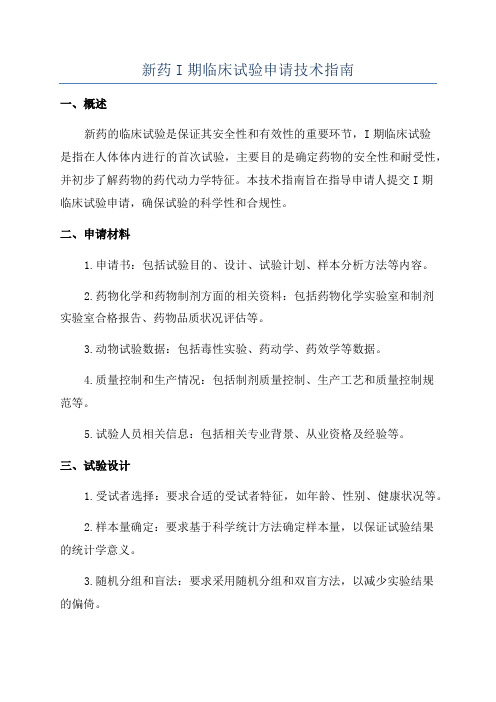
新药I期临床试验申请技术指南一、概述新药的临床试验是保证其安全性和有效性的重要环节,I期临床试验是指在人体体内进行的首次试验,主要目的是确定药物的安全性和耐受性,并初步了解药物的药代动力学特征。
本技术指南旨在指导申请人提交I期临床试验申请,确保试验的科学性和合规性。
二、申请材料1.申请书:包括试验目的、设计、试验计划、样本分析方法等内容。
2.药物化学和药物制剂方面的相关资料:包括药物化学实验室和制剂实验室合格报告、药物品质状况评估等。
3.动物试验数据:包括毒性实验、药动学、药效学等数据。
4.质量控制和生产情况:包括制剂质量控制、生产工艺和质量控制规范等。
5.试验人员相关信息:包括相关专业背景、从业资格及经验等。
三、试验设计1.受试者选择:要求合适的受试者特征,如年龄、性别、健康状况等。
2.样本量确定:要求基于科学统计方法确定样本量,以保证试验结果的统计学意义。
3.随机分组和盲法:要求采用随机分组和双盲方法,以减少实验结果的偏倚。
4.试验组和对照组:要求明确区分试验组和对照组,对照组使用安慰剂或基线治疗。
5.试验方案和观察指标:要求明确试验方案和观察指标,包括药物给予剂量、给药途径、给药频率、观测时间点等。
四、试验过程1.试验药物管理:要求严格按照试验方案给予药物,并记录药物给予情况和不良事件。
2.试验数据记录和统计:要求记录试验数据和不良事件,保证数据的可靠性和一致性。
3.药物浓度测定:要求采用准确的分析方法测定药物浓度,确保药物浓度的准确性。
4.不良事件的处理:要求及时记录不良事件,并采取适当的处理措施。
如有需要,应停止试验并报告监管部门。
5.试验完结和总结:要求试验完结后进行数据总结和分析,并撰写试验报告。
五、伦理与合规1.受试者知情同意:要求征得受试者的知情同意,并确保其随时可以终止试验。
2.试验伦理审查:要求按照相关法规进行伦理审查,确保试验符合伦理原则和道德要求。
3.守信承诺和保密:要求申请人保证试验数据的保密性和互相守信,防止数据泄露和误用。
新药I期临床试验申请申报资料要求

附件3
新药Ⅰ期临床试验申请申报资料
一、申报资料基本要求
申请人应参照《新药I期临床试验申请技术指南》(国家食品药品监督管理总局通告2018年第16号),提供下述资料:
1.文件目录;
2.介绍性说明和总体研究计划;
3.研究者手册;
4.临床试验方案或草案;
5.药学研究信息;
6.非临床研究信息;
7.既往临床使用经验说明;
8.境外研究资料。
同时,还应提供如下信息:
1.药物警戒系统建立情况;
2.临床试验相关方名录;
3.伦理委员会审查相关资料;
4.申报前沟通交流资料。
二、申报资料重点关注
重点关注如下内容:
1.临床试验方案的完整性、科学性和可操作性。
—1 —
2.支持性研究数据的充分性。
鼓励采用CTD格式,提交包括药学研究、非临床研究、境外或早期临床研究等支持性研究数据。
除了综述和总结部分外,应提供完整的各专业研究报告。
3.申报前沟通交流情况。
应提供沟通交流会议纪要(如有),以及根据纪要精神相关研究的完成情况。
4.受试者安全性风险控制。
应根据临床研发计划和临床试验方案,说明药物安全委员会和构建药物警戒系统的组建情况。
5.临床试验利益相关方。
应提供包括研究者姓名和资质、主要研究机构、独立数据监察委员会等在内的临床试验相关方名录信息。
—2 —。
新药I期临床试验申请技术指南

附件新药I期临床试验申请技术指南一、前言为帮助新药注册申请人(药品企业、科研机构和科研人员)申请I期临床试验,提高新药研发与审评效率,保护受试者安全与权益,保证临床试验质量,特发布本技术指南。
本指南阐述了新药在我国开展首次临床试验时需要向国家食品药品监督管理总局药品审评中心(以下简称药审中心)提供的信息。
本指南的目的是:明确新药I期临床试验的技术要求,提高I 期临床试验申报资料的质量;通过规范I期临床试验资料的数据要求,缩短新药研发周期,加快新药上市进程。
本指南适用于创新药和改良型新药,包括化学药品和治疗用生物制品(细胞和基因治疗产品除外)。
二、咨询与沟通交流如果申请人在研发及申请临床试验过程中有疑问,可通过药审中心网站查询相关指导原则,也可以按照相关规范通过药审中心网站“申请人之窗”就相关问题进行咨询。
递交新药临床试验申请前,申请人可按照《药物研发与技术审评沟通交流管理办法》所规定的方法与工作程序,申请与药审中心召开临床试验申请前会议。
— 1 ——申请人与药审中心间的沟通有助于提高临床试验申请的质量,加快后续研究与审评的进程。
三、I期临床试验申请的技术要求(一)资料格式及内容I期临床试验申请的申报资料应以纸质资料和电子资料方式提交,电子资料可以CD的形式送交。
格式和内容可参照研究人用药品注册技术要求国际协调会(ICH)通用技术文件(CTD)的要求整理提交。
(二)介绍性说明和总体研究计划介绍性说明应包括新药的名称、所有的活性成分、药理作用类别、结构式(如果已知)、剂型、制剂处方、给药途径、临床试验目的等。
如果有所研究药物用于临床的经验,应提供简短概述,包括在其他国家的研究和上市的经验;若没有,标题下写“无”。
总体研究计划应总结申请临床试验方案的设计依据,主要为拟定的适应症、受试者人群、受试者数量、给药方案(剂量、给药间隔、给药持续时间等)、药物安全性评价方法、风险控制计划等,根据已有信息预期的任何安全性(重要的已确定风险、重要的潜在风险、重要的缺失的资料等)的风险论证。
新药I期临床试验申请技术指南20240930

新药I期临床试验申请技术指南20240930一、引言新药研发是保障人民健康的重要工作,I期临床试验是新药研发过程中的重要环节。
为了规范和指导I期临床试验申请工作,制定本技术指南。
二、I期临床试验概述1.I期临床试验是新药研发的第一阶段,目的是评估新药的安全性和耐受性。
2.I期临床试验的实施必须符合伦理要求,并严格遵守药物管理法律法规。
三、I期临床试验申请材料准备1.申请人需在申请I期临床试验前,详细了解试验药物的性质、已有的非临床试验结果以及人体试验的风险与益处。
2.申请材料包括新药临床试验申请报告和新药质量状况报告等。
四、试验设计与方法1.I期临床试验的设计应遵循国际通行的原则和规范,如随机对照、安慰剂对照等。
2.试验目标人群应根据药物特性及预计的治疗效果确定,且应确保试验人员的知情同意。
3.试验的安全与监测计划应根据试验药物的特性和已知的不良反应确定,包括实施严格的不良事件报告和监测。
五、试验干预措施和测量指标1.试验干预措施应明确,包括药物剂量、给药途径等。
2.测量指标应与试验目的相符,可包括生化指标、疗效评价指标等。
六、试验计划执行1.试验应在专业的医疗机构或研究机构进行,试验人员应具备相关资质和技术。
2.试验期间应对试验人员进行核查和培训,以确保试验的严谨性和准确性。
七、试验风险与安全措施1.试验主体应提前评估试验人员可能面临的风险,并提供相关的安全措施。
2.在试验期间,应有专业的安全监测团队负责试验人员的安全监测和风险评估。
八、数据统计与分析1.试验数据的收集应遵循规定的流程和标准,确保数据的完整性和准确性。
2.数据的统计与分析应由专业的统计学家进行,遵循规定的统计学原则。
九、I期临床试验结果报告1.I期临床试验结果报告应提供详细的数据和分析结果,以及结论和讨论部分。
2.报告应完整、准确地反映试验结果,不得歪曲或隐瞒试验结果。
十、总结与展望本技术指南的制定旨在规范和指导新药I期临床试验申请工作,并为保障人民的健康提供科学依据。
中药i类新药 申请 -回复
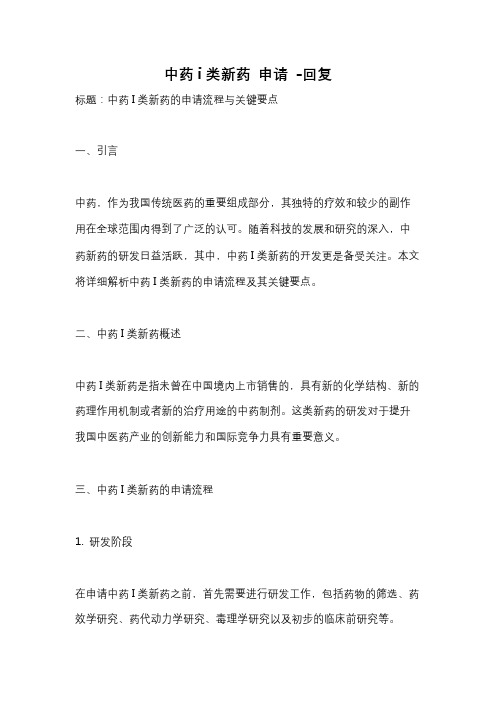
中药i类新药申请-回复标题:中药I类新药的申请流程与关键要点一、引言中药,作为我国传统医药的重要组成部分,其独特的疗效和较少的副作用在全球范围内得到了广泛的认可。
随着科技的发展和研究的深入,中药新药的研发日益活跃,其中,中药I类新药的开发更是备受关注。
本文将详细解析中药I类新药的申请流程及其关键要点。
二、中药I类新药概述中药I类新药是指未曾在中国境内上市销售的,具有新的化学结构、新的药理作用机制或者新的治疗用途的中药制剂。
这类新药的研发对于提升我国中医药产业的创新能力和国际竞争力具有重要意义。
三、中药I类新药的申请流程1. 研发阶段在申请中药I类新药之前,首先需要进行研发工作,包括药物的筛选、药效学研究、药代动力学研究、毒理学研究以及初步的临床前研究等。
2. 申报材料准备完成研发阶段后,需要准备详细的申报材料,包括药物的研究报告、生产工艺、质量标准、稳定性试验、药理毒理研究报告、临床前研究资料等。
3. 申请临床试验向国家药品监督管理局(NMPA)提交临床试验申请,包括临床试验方案、伦理审查意见、受试者保护措施等内容。
4. 临床试验阶段获得临床试验批件后,进行临床试验,包括Ⅰ期、Ⅱ期、Ⅲ期临床试验,以评估药物的安全性、有效性和最佳用药方案。
5. 申请生产上市完成临床试验并取得积极结果后,向NMPA提交新药生产上市申请,包括临床研究报告、药品生产质量管理规范(GMP)认证、药品标签和说明书等。
6. 审评审批NMPA对申报材料进行全面审评,包括对药物的安全性、有效性和质量可控性的评价。
审评通过后,颁发药品注册证书,允许药品上市销售。
四、中药I类新药申请的关键要点1. 科研实力中药I类新药的研发需要强大的科研实力支持,包括高水平的研发团队、先进的实验设备和严谨的科研方法。
2. 资料完整性和准确性申报材料的完整性和准确性是决定新药申请能否成功的关键因素。
所有数据和信息必须真实、准确、完整,且符合相关法规和技术要求。
- 1、下载文档前请自行甄别文档内容的完整性,平台不提供额外的编辑、内容补充、找答案等附加服务。
- 2、"仅部分预览"的文档,不可在线预览部分如存在完整性等问题,可反馈申请退款(可完整预览的文档不适用该条件!)。
- 3、如文档侵犯您的权益,请联系客服反馈,我们会尽快为您处理(人工客服工作时间:9:00-18:30)。
附件新药I期临床试验申请技术指南一、前言为帮助新药注册申请人(药品企业、科研机构和科研人员)申请I期临床试验,提高新药研发与审评效率,保护受试者安全与权益,保证临床试验质量,特发布本技术指南。
本指南阐述了新药在我国开展首次临床试验时需要向国家食品药品监督管理总局药品审评中心(以下简称药审中心)提供的信息。
本指南的目的是:明确新药I期临床试验的技术要求,提高I 期临床试验申报资料的质量;通过规范I期临床试验资料的数据要求,缩短新药研发周期,加快新药上市进程。
本指南适用于创新药和改良型新药,包括化学药品和治疗用生物制品(细胞和基因治疗产品除外)。
二、咨询与沟通交流如果申请人在研发及申请临床试验过程中有疑问,可通过药审中心网站查询相关指导原则,也可以按照相关规范通过药审中心网站“申请人之窗”就相关问题进行咨询。
递交新药临床试验申请前,申请人可按照《药物研发与技术审评沟通交流管理办法》所规定的方法与工作程序,申请与药审中心召开临床试验申请前会议。
—1 —申请人与药审中心间的沟通有助于提高临床试验申请的质量,加快后续研究与审评的进程。
三、I期临床试验申请的技术要求(一)资料格式及内容I期临床试验申请的申报资料应以纸质资料和电子资料方式提交,电子资料可以CD的形式送交。
格式和内容可参照研究人用药品注册技术要求国际协调会(ICH)通用技术文件(CTD)的要求整理提交。
(二)介绍性说明和总体研究计划介绍性说明应包括新药的名称、所有的活性成分、药理作用类别、结构式(如果已知)、剂型、制剂处方、给药途径、临床试验目的等。
如果有所研究药物用于临床的经验,应提供简短概述,包括在其他国家的研究和上市的经验;若没有,标题下写“无”。
总体研究计划应总结申请临床试验方案的设计依据,主要为拟定的适应症、受试者人群、受试者数量、给药方案(剂量、给药间隔、给药持续时间等)、药物安全性评价方法、风险控制计划等,根据已有信息预期的任何安全性(重要的已确定风险、重要的潜在风险、重要的缺失的资料等)的风险论证。
(三)研究者手册研究者手册是有关试验药物在进行人体研究时已有的药学、非临床与临床研究(如有)资料总结,旨在为临床研究者提供所研究药物的信息,以保证受试者安全。
—2 —当有新的重要信息时,申请人应及时更新研究者手册,使其包括对研究药物的所有重要研究信息的总结。
更新的研究者手册应及时报送药审中心。
研究者手册的格式和内容可参照ICH E6有关章节撰写。
研究者手册应包括如下内容:1.封面页:包括药物名称,注册申请人名称,完稿或更新日期以及版本号;2.目录:列出所有的一级标题、二级标题以及相应的页码;3.保密声明;4.概述:介绍药物种类,拟定适应症及药理特征;5.新药名称与理化性质:简要说明药物的名称、化学名(如有)、分子量、分子式、结构式(如有)、理化特性、剂型、根据已有的稳定性数据拟定的临时效期、保存条件、使用注意事项等;6.非临床研究结果6.1药理作用:应包括已完成的用于提示药效的非临床试验结果。
6.2毒理研究:分项列出安全药理学试验、单次给药毒性试验、重复给药毒性试验、遗传毒性试验、生殖毒性试验、致癌试验以及其他毒性试验。
如果有些研究还没有进行或不需要进行,需要说明理由和依据。
6.3非临床药代动力学研究:应包括药物的吸收、分布、代谢及排泄(ADME)。
如果有些研究还没有进行或不需要进行,需要说明理由和依据。
—3 —7.已有临床研究或使用资料(如有):应包括国内或国外现有的所有临床试验信息及文献资料。
7.1人体药物代谢动力学7.2有效性7.3安全性7.4上市情况8.其他若尚未有新药使用信息,应基于对已有的非临床和临床研究结果的总结,提供申请人认为相关的信息:可能包括特殊人群、安全性信息、警告及注意事项、风险控制计划、药物相互作用、药物过量等。
9.参考文献(四)临床试验方案临床试验方案应包含下列信息:1.研究背景,简述药物的适应症情况,简述药物已有的临床有效性及安全性资料(如有);2.试验目的;3.预计参加的受试者数量;4.入选标准和排除标准描述;5.给药计划描述,包括持续时间、起始剂量、剂量递增方案和终止条件、给药方案并描述首剂量确定依据和方法;6.检测指标、对受试者安全性评价至关重要的相关试验详细信息,如受试者生命体征和必要的血液生化监测;—4 —7.中止研究的毒性判定原则和试验暂停标准。
(五)药学研究信息新药的药学研究随着药物研究进展不断深入,在不同研究阶段有不同的研究目的。
对于新药申请Ⅰ期临床研究的药学研究资料,应遵循药物研发的规律,重点关注对计划研究的受试者安全性相关的药学研究信息(如基于现有知识对杂质谱的解析,有关物质检查专属性、灵敏度的方法学验证,潜在遗传毒性杂质分析和控制,生物新药的免疫原性和免疫毒性等)。
根据药学部分所提供的信息,当对安全性问题产生担忧或数据不足以进行安全性评价时,应暂缓临床试验。
产生担忧的原因可能包括但不限于以下情形:(1)新药化学结构或制剂辅料具有已知毒性或极可能具有毒性;(2)在计划实施的整个I期临床试验项目期间,新药不能保持稳定性;(3)新药的杂质特征显示具有潜在毒性,或者新药中含量在鉴定限以上的杂质未进行充分鉴定且未对其潜在的毒性进行评估;(4)存在动物源性成分的生物安全性问题;(5)主细胞库或工作细胞库未经过充分鉴定。
申请人应分析已有药学研究信息是否显示潜在的人体风险,并对这些潜在的风险进行讨论,阐述为控制或监测该风险所计划采取的措施。
—5 —对于具有生物毒性、带有放射性核素等的新药,或涉及生物安全性风险的新药,应按照国际通用的相关技术指导原则提供相关研究资料、研究计划及风险控制措施。
1.化学药品药学研究信息新药申请人应对动物研究用样品及拟进行人体试验用样品进行分析比较(可列表说明),如有差异需讨论差异可能对临床安全性造成的影响,从而为后续的人体试验提供安全性方面的支持。
对申请Ⅰ期临床研究的化学药品需要提供下列药学研究资料,同时,按照附件表格总结整理和提供化学药品Ⅰ期临床试验申请药学研究信息汇总表并电子提交。
1.1原料药信息1.1.1生产厂商应递交原料药生产厂商(包括生产、检验)的完整地址。
1.1.2制备工艺应提供原料药制备工艺资料,包括反应流程图,注明工艺中使用的试剂、溶剂和催化剂等。
对于采用发酵工艺、提取工艺制备以及多肽、小分子核酸药物等,需要提供更多的制备工艺信息。
对于无菌原料药需提供灭菌/除菌工艺和无菌保证措施。
1.1.3结构确证应提供结构确证使用的方法、图谱及简要的结构解析总结。
1.1.4理化性质应列出已研究的可能与制剂性能相关的原料药的晶型、溶解度、渗透性、粒度等关键理化特性。
—6 —如可能,列明不同介质(如不同pH)中的具体溶解度数据。
1.1.5质量控制应提供初步的质量标准,说明检查项目、可接受的限度、分析方法,提供代表性图谱。
在药品开发初期,不需要提交全面完整的分析方法验证资料,但至少应提供方法的专属性、灵敏度等关键验证信息。
应提供样品检验报告书。
提供关键研究批次(如用于安全性研究、稳定性研究、临床研究等)的批分析数据。
应提供初步的杂质谱分析结果、潜在遗传毒性杂质控制策略和分析信息。
可参照ICH M7指南研究并提交报告。
1.1.6稳定性应提供原料药稳定性研究资料,列明采用的分析方法,可用列表形式递交代表性样品的初步数据及其他支持性稳定性研究数据,应提供关键项目的代表性图谱。
稳定性数据应能支持新药的理化参数在计划的临床研究期间符合要求,如果计划的试验周期极短,可提供有限的支持性稳定性数据。
在确保临床试验期间药物的稳定性的基础上,逐步积累稳定性数据,支持进一步的临床开发。
1.1.7包装及贮存应列明的直接接触包装材料及贮存条件。
1.2 制剂信息1.2.1剂型及产品组成应列表说明制剂的处方组成及用量,对于制剂工艺中使用但—7 —最终去除的组分也应列出。
制剂中的辅料应符合药用要求;对于国内外制剂中尚未使用过的全新辅料,应进行关联申报。
1.2.2生产厂商名称与地址应递交临床试验用制剂生产厂商(包括生产、包装、检验)的完整地址。
1.2.3生产工艺和工艺控制应提供生产工艺信息,包括工艺流程图。
对于无菌制剂应提供灭菌工艺和无菌保证措施;非常规工艺制剂应提供较详细的工艺描述。
1.2.4质量控制应提供初步的质量标准。
说明检查项目可接受的限度、分析方法、代表性图谱。
杂质报告方式可参照ICH Q3A和Q3B。
应根据剂型、产品特点等设置适宜的质控项目和分析方法。
对于以积累数据为目的,但不作为制剂放行条件的检测项目,应予以注明。
在药品开发初期,不需要提交全面完整的分析方法验证资料,但至少应提供方法的专属性、灵敏度等关键项目的验证信息。
提供关键研究批次(如用于安全性研究、稳定性研究、临床研究等)的检验报告书。
应提供制剂降解途径、降解产物的初步研究结果。
可参照ICH Q3B。
1.2.5稳定性应提供制剂稳定性研究资料,列明采用的分析方法,可用列表形式提交代表性样品(如动物药理毒理学研究样品、拟用于临床试验的样品)的初步数据及其他支持性稳定性研究资料,应提—8 —供关键项目的代表性图谱。
稳定性数据应能支持制剂的理化参数在计划的临床研究期间符合要求,如果计划的试验周期极短,可提供有限的支持性稳定性数据。
1.2.6包装和贮存条件应列明直接接触包装材料的信息和贮存条件。
对于新材料、新结构、新用途的药包材,需提供信息并按照要求进行关联申报。
1.2.7其他对于临床需要进行配伍使用及有特殊使用要求的制剂应提供相关稳定性实验结果。
1.3安慰剂信息如临床试验方案中需使用安慰剂,应提供安慰剂的处方、生产工艺及生产厂的相关信息、质量控制和检验结果等研究资料。
2.生物制品药学研究信息提供药学研究结果的摘要性小结资料,对于拟定质量标准中低于药典控制基本要求,或者低于通用的技术指导原则要求的质控项目给予阐释说明;对于药学研究中发现并需要提请审评特别关注的疑难问题给予重点说明。
2.1生产用原材料2.1.1应提供生产用起始材料的名称、来源、质量标准、安全性等信息,生产用起始材料应符合现行版《中华人民共和国药典》标准或《中华人民共和国药典》三部“生物制品生产用原材料及辅料质量控制规程”的相关要求,按照风险等级分级,提供—9 —相应的证明性文件和/或质控检测报告等。
2.1.2工程细胞(菌)建立和鉴定采用基因重组技术表达的蛋白,应提供氨基酸序列,如对目的基因进行改构或突变,申请人可结合对产品结构和功能的影响进行初步说明。
提供表达载体的名称、来源、结构和遗传特性,应对重组表达载体进行结构确定。
提供宿主细胞(菌)及构建的工程细胞(菌)的名称、来源、安全性、培养特性、生物学特性(基因型和表型)、传代历史(包括驯化过程)、检定结果等,说明是否曾进行基因操作引入外源基因序列。
